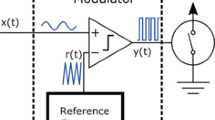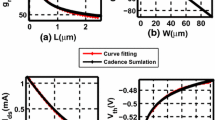Abstract
This research describes an adaptation-based control strategy to deal with the pulse-width pulse-frequency modulator. The subject behind the research is to control the above-referenced modulators the hard limiter block via closed-loop describing function representation. In a word, this modulator has a set of parameters, which are all in need of adjusting, accurately, in order to guarantee its high performance, in the entire areas of overall systems under control. The investigated results indicate that parameter’s adjustment of the aforementioned pulse-width pulse-frequency modulator can be recognized as the state-of-the-art outcomes via adaptation rules.











Similar content being viewed by others
References
Vander V and Wallace E 1968 Multiple-input describing functions and nonlinear system design. McGraw-Hill. New York
Krovel T 2005 Optimal tuning of PWPF modulator for attitude control, Master’s thesis. Norwegian University of Science and Technology, Trondheim, Norway
Bailing T, Lihong L, Hanchen L, Zongyu Z, Qun Z and Yunpeng Z 2018 Multivariable finite time attitude control for quadrotor UAV: Theory and experimentation. IEEE Transactions on Industrial Electronics 65 (3): 2567–2577
Peng L, Zheng H Z and Meguid S A 2016 State dependent model predictive control for orbital rendezvous using pulse-width pulse-frequency modulated thrusters. Advances in Space Research 581:64–73
Yijun L and Guojian T 2013 Libration point orbit rendezvous using PWPF modulated terminal sliding mode control. Advances in Space Research. 52 (12): 2156–2167
Navabi M and Rangraz H 2013 Comparing optimum operation of pulse width-pulse frequency and pseudo-rate modulators in spacecraft attitude control subsystem employing thruster. In: International Conference on Recent Advances in Space Technologies 625–630
Wang X and Zhang H 2015 Fractional order controller for satellite attitude control system with PWPF modulator. In: Chinese Control Conference. Hangzhou, China, 5758–5763
Gangbing S and Brij N A 2001 Vibration suppression of flexible spacecraft during attitude control. Acta Astronautica 49 (2) :73-83
Leonangeli N, Sabatini M, Palmerini G B and Gasbarri P 2013 Experimental investigation of on-off control modulation for rigid and flexible free floating platforms. IFAC Proceedings. 4619: 19–24
Author information
Authors and Affiliations
Corresponding author
Rights and permissions
About this article
Cite this article
Mazinan, A.H. On pulse-width pulse-frequency modulator control strategy: An adaptation-based describing function representation. Sādhanā 45, 114 (2020). https://doi.org/10.1007/s12046-020-01339-9
Received:
Revised:
Accepted:
Published:
DOI: https://doi.org/10.1007/s12046-020-01339-9




